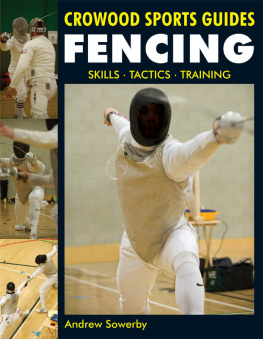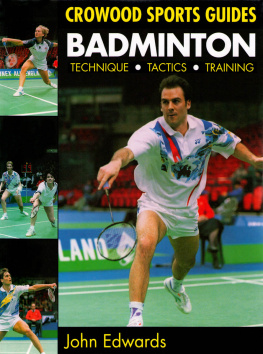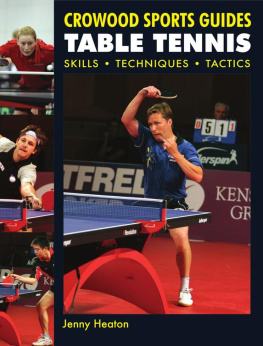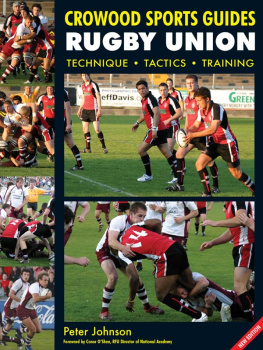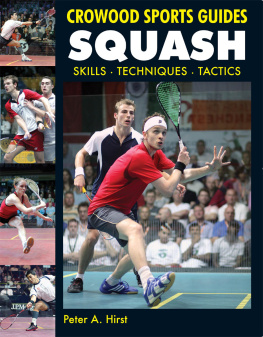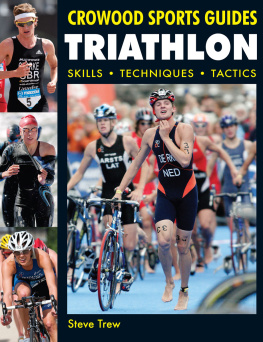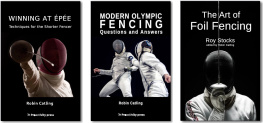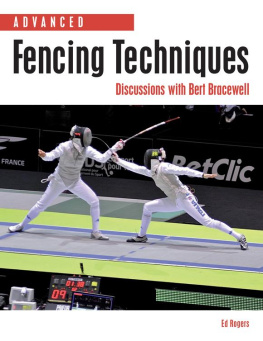
CROWOOD SPORTS GUIDES
FENCING
SKILLS TECHNIQUES TRAINING
Andrew Sowerby

THE CROWOOD PRESS
First published in 2011 by
The Crowood Press Ltd
Ramsbury, Marlborough
Wiltshire SN8 2HR
www.crowood.com
This e-book first published in 2014
The Crowood Press Ltd 2011
All rights reserved. No part of this publication may be reproduced or transmitted in any form or by any means, electronic or mechanical, including photocopy, recording, or any information storage and retrieval system, without permission in writing from the publishers.
British Library Cataloguing-in-Publication Data
A catalogue record for this book is available from the British Library.
ISBN 978 1 84797 855 4
Photographs by Steve Wright Photography
CONTENTS
PREFACE
Fencing is a sport that has changed greatly over the years in competition, but the technique remains the same. The aim of this book is to explain to the beginner and improver how to fence, as well as why and when to fence to the more advanced practitioner. It is intended to complement your fencing class, in that the order of the techniques given here should follow the way you are being taught in a class.
Rather than write about all the techniques in fencing in limited detail, I have chosen to look at the main techniques required to be a good fencer in more detail. Each chapter therefore leads on in a logical manner from the previous one. For example, ,The Parry-Riposte Defence, which shows how to deal with the direct attack. All examples in later chapters refer to techniques that have been previously learnt.
In , Tactics, we examine the application of the techniques in the fight situation. We also look at things from a left-handers point of view, as well as giving tips on competition and drill exercises.
The book focuses on foil fencing, but there is also an introduction to the pe and the sabre.
Having been involved in fencing as a competitor since 1982 and a full-time professional coach since 1988, teaching children as young as nine and adults of all ages, the system laid down here is tried and tested, producing fencers who fence purely for social reasons as well as competitors at all levels.
Dedication
Special thanks to Carole, Oliver, Will and David for their patience and help in writing this book. Thanks also to all pupils and ex-pupils for their contributions.

CHAPTER 1
THE HISTORY OF FENCING
Duelling
First, some fencing history. The foil developed from the Italian floretta, which was a light thrusting sword that was used for the practice of duelling up to the eighteenth century. Its purpose was to practise the moves used in a duel without causing injury.
A person of good breeding was often involved in duels, so practice under the guidance of a fencing master was essential for survival. The duellist was trained to thrust to kill, therefore the trunk of the body where all the vital organs are contained was the main area to hit. In modern foil fencing, we refer to this as on- and off-target hits, with on target being the trunk of the body. The term character of penetration used in foil simulates the penetration of the point into the trunk with a bending of the blade, or, in electric competition fencing, 500g pressure on a switch. Fencing today would bear little resemblance to duelling techniques. The bladework would have been very limited and the approach cautious and slow understandably so, considering your life would have been at stake. Without room for error, you would not be able to experiment.
Many famous duels and duellists are documented, notably Franois de Montmorency, who had the habit of walking up to any man and saying, I understand, sir, that you are a brave man, I should like to allow you to prove it. Another famous duelist was the Chevalier dAndrieux, who by the age of thirty had killed seventy-two men in duels. It is reported that one opponent boasted, Chevalier, you will be the tenth man that I have killed, to which dAndrieux replied, and you will be my seventy-second.
In France, so many men were being killed in duels over matters of little importance that in 1679 stricter legislation was brought in to try to curb it. If a man was killed in a duel, it was now considered to be murder. One of the ways the duellist would get round this law was by being the first to draw blood. A scratch on the arm or leg therefore would be enough to satisfy honour and the duel was won. Modern pe fencing simulates this drawing of blood with points scored by hits anywhere on the body.
The Beginning of the Sport of Fencing
With the development of the duelling pistol, the sword died out as the weapon of choice. When challenged, most would opt for the pistol, therefore the sword became something that could be used for sport. This was aided by the creation of the mask in 1765 to protect the face. The development of what was to become known as the conversation of the blade had started.
Italian fencing master Domenico Angelo was one of the first to develop fencing as a means of health and elegance. Under his guidance, fencing became a sport rather than a means to kill. Studying in Pisa, Italy, before moving to Paris to study the French method, he then set up a fencing school in London in 1756. He taught the art of the sword to the nobility. In 1763 he published his cole des armes, containing forty-seven plates showing fencing techniques.
The two main schools of fencing at this time were the French and the Italian. The French school was considered more progressive and the Italian more conservative. Over the course of the next 200 years, fencing techniques started to develop, with the two main schools being very secretive about the development of their own techniques. However, as travel became more accessible, fencers would visit the fencing schools and pick up techniques to add to their repertoire, with the result that today we have a mix of both schools in the modern game. French and Italian fencers have dominated the medals in most Olympic Games, none more so than Italian brothers Aldo and Nedo Nadi, with Aldo winning three gold medals and Nedo also three. In the 1920 Olympic Games, Aldo won gold medals in all three disciplines foil, pe and sabre.
With the invention of the electric scoring system in the 1930s, judges were replaced with a scoring system that would reliably record a hit. This system transformed the sport, with many new techniques coming into use that would not have been employed when relying on only the human eye to see them. In the modern competitive sport, although we still have the many different techniques that have been developed over the centuries, the competitive fencer will rely on certain offensive and defensive actions, as well as their tactical application. In lessons, the aim is to get close to the fight situation, with the repetition of actions under as many different situations as possible.

Domenico Angelos cole des armes, showing three disarming techniques.
CHAPTER 2
GETTING STARTED
Next page
